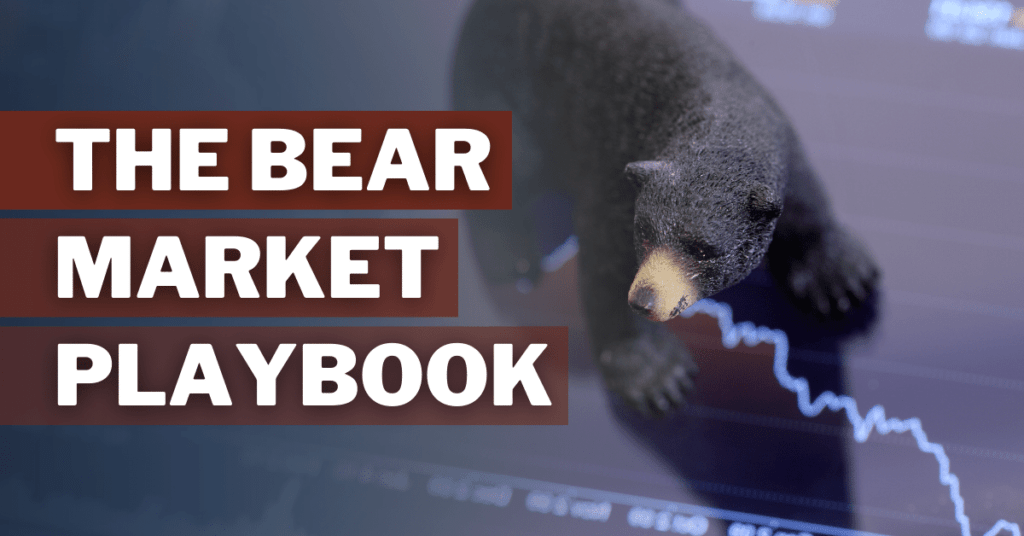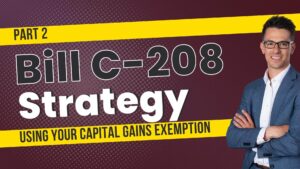[vc_row][vc_column][vc_column_text css=”.vc_custom_1655224320509{padding-top: 20px !important;padding-bottom: 20px !important;}”]As we find ourselves in a new bear market, let’s review three different strategies for making the most of this market condition. The Bear Market Playbook bases each strategy on a different risk tolerance level.
Option 1: Poke the Bear
Rebalance Your Portfolio
Rebalancing your portfolio is the process of making trades to move your portfolio back to its initial asset allocation. This is best explained by going through an example.
Let’s say that when you first started investing, you chose a portfolio of 60% equity and 40% fixed income. Since then, your equities (aka stocks) declined by 20%, while your fixed income held steady – no gain or loss (0%). Your current equity to fixed income ratio is now 54.5% equity and 45.5% fixed income. To rebalance, you would sell some of your fixed income (precisely 5.5%) and purchase equities (precisely 5.5%) to bring your portfolio back to its original 60% equity, 40% fixed income ratio.
Why does it make sense to do this in a bear market?
Rebalancing during a bear market allows you to buy stocks for a low price and then sell those same stocks at a high price once the markets recover. Buy low, sell high. Let’s continue with our example.
Stock markets are down 20% and you have rebalanced your investment portfolio back to 60% equity and 40% fixed income. Eight months later, stock markets recover and hit new all-time highs. Equities are up 25% since you rebalanced, and your fixed income once again held steady at 0%. Your new ratio is 65.2% equity and 34.8% fixed income. In this scenario, when you rebalance, you would sell 5.2% of your equity and move it to fixed income, bringing your portfolio back to 60% equity and 40% fixed income. You sold high and locked in that 5.2% gain you made in your equities.
This may sound simple, but many investors fail to rebalance their portfolios. Studies have shown that annual portfolio rebalancing can add 0.26% to your annual returns.
Source: https://advisors.vanguard.com/iwe/pdf/ISGQVAA.pdf
Option 2: Attack the Bear
For those of you who are looking to get more aggressive and take advantage of stocks trading at a discount, the following strategy is something to consider. Please speak with a professional before implementing this suggestion.
Invest Now!
Much easier said than done.
Clients ask me, “Is now a good time to invest?”, “Is the market going to continue falling?”, because if so, they want to wait to invest until it hits the bottom or at least starts to recover. The short answer is, “I don’t know where the market bottom is going to be, and neither does anyone else.”
Therefore, instead of trying to be a fortune teller, the best advice I can give you is to attack the bear markets with a strategy that diminishes emotion. Many investors let their emotions get the best of them and they miss the opportunity to buy low because it “doesn’t look like a good time.” I hate to say it, but it’s never going to “look like a good time” to invest during a bear market.
That’s the whole point of bear markets. There’s fear, people are panicking, the media is sensationalizing everything, and the world looks like it’s going to end. You need a strategy that drowns out the noise.
See my previous article, Should you sell now and buy back later? for a more in-depth analysis.
How to INVEST NOW in a Bear Market
First, investing in a bear market is a great opportunity and not something you should run from. But if you don’t believe things will eventually recover, then this strategy may not be for you. (For more information and tips on how to prepare emotionally for bear markets, see Getting ready for a bear market.)
Once you’re ready to buy low, figure out how much you’re comfortable investing. Make sure you leave enough cash on hand to fund any short-term expenses.
Now you have two options:
- Take 100% of the cash you’re comfortable investing and put it all to work right away
Theory: There is no guarantee that markets will continue to drop, so take advantage of the 20% decline. You will be happy with your 25% rate of return once markets recover. Even if it takes a couple of years, you would still average 12.5%/year. (For more on market recovery and rates of return, see our previous blog post The $100 you invest today will be worth $143 once the market recovers.)
- Split your cash into three pots and invest on three separate occasions
Theory: It’s easy for me to say, “just put it all in,” but I know how scary that can be when all you hear and read is negative. Therefore, instead of taking the full plunge, try taking baby steps. A strategy I have seen work well with clients is investing a third of their cash when the markets first hit -20%, another third when markets hit -25%, and their final third when markets hit -30%. Psychologically, this strategy is easier to implement as you’re not going all in right away. Now obviously, if the bear market only drops to a low of -24% before it starts to recover, you will have two-thirds of your cash that was never invested, and you’ll miss the upside. For some, this may be a tradeoff they are willing to accept in order to sleep at night.
Option 3: Slay the Bear
This final strategy is for aggressive investors with experience and knowledge of stock markets. This is not something we would recommend clients do unless they fully understand all of the risks. Please speak with a professional before implementing this suggestion.
Borrow to Invest
What if you don’t have any extra cash to take advantage of the markets being low? What if you’d rather keep your cash and tap into some equity that you’ve built up in your home or business instead?
Borrowing to invest, also known as leveraging, is a way to supercharge your rate of return and slay the bear.
Say you have the ability to borrow $100,000 against your house. If the interest rate on a home equity line of credit is 5%, you will be paying $5,000 over the next 12 months in interest for borrowing the money.
If you invest the $100,000 today while stock markets are down 20%. One year later, when the stock markets have recovered, your $100,000 will have turned into $125,000*. You then sell your portfolio, pay off the $100,000 loan, and you are left with $25,000.
You spent $5,000, and you made $25,000. That’s a 400% rate of return!
(*See The $100 you invest today will be worth $143 once the market recovers for a further explanation of how the above calculation works.)
Potential Risks
What if it takes longer than a year to recover?
The following are estimates of expected returns according to the number of years it takes the market to recover.
- One year to recover: 400% rate of return
- Two years to recover: 150% rate of return
- Three years to recover: 66% rate of return
- Four years to recover: 25% rate of return
- Five years to recover: 0% rate of return
- Six years to recover: -17% rate of return
What if interest rates rise?
Rising interest rates will negatively affect your rates of return as you will need to put more cash towards paying the interest.
What about tax? Taxes could also eat into your net rate of return depending on the account type into which you invest your $100,000.
Because of these and other potential risks, I would recommend you wait for a larger drop in the stock market. Imagine borrowing to invest when the stock market is down 20%, only to see it continue to drop down to 30%. Not only is your investment down, but you also still owe $100,000 and you’re paying interest every month. Again, this is a very high-risk strategy.
By waiting for a larger drop, your chances of this strategy working well increase dramatically. See the chart below to get an idea of how long it has taken the S&P 500 to recover from rock bottom during past bear markets.[/vc_column_text][dt_fancy_image image_id=”8724″ width=”1000″ css=”.vc_custom_1655155110157{padding-top: 20px !important;padding-bottom: 20px !important;}”][vc_column_text css=”.vc_custom_1655155118614{padding-top: 20px !important;padding-bottom: 20px !important;}”]Source: https://awealthofcommonsense.com/2020/03/how-long-does-it-take-to-make-your-money-back-after-a-bear-market/
Summary
If I were to summarize all of these strategies, it’s quite simple: When a bear market occurs, come back up more invested than you did when you went down, and you’ll be duly rewarded.
Important disclaimer:
These strategies are not suitable for everyone. The information is intended to provide general guidance on matters of interest for the personal use of the viewer who accepts full responsibility for its use and is not to be considered a definitive analysis of the legal and factual situation of any particular individual or entity. As such, it should not be used as a substitute for a professional consultation regarding accounting, taxation, or legal matters.
[/vc_column_text][/vc_column][/vc_row]









